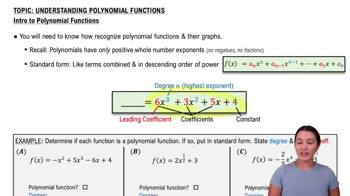Table of contents
- 0. Functions7h 52m
- Introduction to Functions16m
- Piecewise Functions10m
- Properties of Functions9m
- Common Functions1h 8m
- Transformations5m
- Combining Functions27m
- Exponent rules32m
- Exponential Functions28m
- Logarithmic Functions24m
- Properties of Logarithms34m
- Exponential & Logarithmic Equations35m
- Introduction to Trigonometric Functions38m
- Graphs of Trigonometric Functions44m
- Trigonometric Identities47m
- Inverse Trigonometric Functions48m
- 1. Limits and Continuity2h 2m
- 2. Intro to Derivatives1h 33m
- 3. Techniques of Differentiation3h 18m
- 4. Applications of Derivatives2h 38m
- 5. Graphical Applications of Derivatives6h 2m
- 6. Derivatives of Inverse, Exponential, & Logarithmic Functions2h 37m
- 7. Antiderivatives & Indefinite Integrals1h 26m
- 8. Definite Integrals4h 44m
- 9. Graphical Applications of Integrals2h 27m
- 10. Physics Applications of Integrals 2h 22m
4. Applications of Derivatives
Differentials
Problem 47
Textbook Question
Mean Value Theorem for quadratic functions Consider the quadratic function f(x) = Ax² + Bx + C, where A, B, and C are real numbers with A ≠ 0. Show that when the Mean Value Theorem is applied to f on the interval [a,b], the number guaranteed by the theorem is the midpoint of the interval.
 Verified step by step guidance
Verified step by step guidance1
The Mean Value Theorem (MVT) states that for a function f that is continuous on the closed interval [a, b] and differentiable on the open interval (a, b), there exists at least one number c in (a, b) such that f'(c) = (f(b) - f(a)) / (b - a).
First, find the derivative of the quadratic function f(x) = Ax² + Bx + C. The derivative is f'(x) = 2Ax + B.
Next, apply the MVT by setting f'(c) = (f(b) - f(a)) / (b - a). Substitute f'(c) = 2Ac + B and calculate f(b) = Ab² + Bb + C and f(a) = Aa² + Ba + C.
Calculate the difference quotient: (f(b) - f(a)) / (b - a) = [(Ab² + Bb + C) - (Aa² + Ba + C)] / (b - a). Simplify this expression to get (Ab² - Aa² + Bb - Ba) / (b - a).
Set the simplified difference quotient equal to 2Ac + B and solve for c. After simplification, you will find that c = (a + b) / 2, which is the midpoint of the interval [a, b].
 Verified video answer for a similar problem:
Verified video answer for a similar problem:This video solution was recommended by our tutors as helpful for the problem above
Video duration:
8mPlay a video:
Was this helpful?
Key Concepts
Here are the essential concepts you must grasp in order to answer the question correctly.
Mean Value Theorem (MVT)
The Mean Value Theorem states that if a function is continuous on a closed interval [a, b] and differentiable on the open interval (a, b), then there exists at least one point c in (a, b) such that the derivative at that point equals the average rate of change of the function over the interval. This theorem is fundamental in understanding the behavior of functions and their derivatives.
Recommended video:

Fundamental Theorem of Calculus Part 1
Quadratic Functions
A quadratic function is a polynomial function of degree two, typically expressed in the form f(x) = Ax² + Bx + C, where A, B, and C are constants and A ≠ 0. The graph of a quadratic function is a parabola, which can open upwards or downwards depending on the sign of A. Understanding the properties of quadratic functions is essential for applying the Mean Value Theorem in this context.
Recommended video:

Introduction to Polynomial Functions
Derivative and its Interpretation
The derivative of a function at a point measures the rate at which the function's value changes as its input changes. For quadratic functions, the derivative is a linear function, which means it has a constant slope. In the context of the Mean Value Theorem, the derivative at the point c represents the instantaneous rate of change, which is equal to the average rate of change over the interval [a, b], leading to the conclusion that c is the midpoint when the function is symmetric.
Recommended video:

Derivatives







